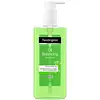What's inside
What's inside
 Key Ingredients
Key Ingredients

No key ingredients
 Benefits
Benefits

 Concerns
Concerns

 Ingredients Side-by-side
Ingredients Side-by-side

Water
Skin ConditioningGlycerin
HumectantSodium Laureth Sulfate
CleansingLauryl Glucoside
CleansingAcrylates/C10-30 Alkyl Acrylate Crosspolymer
Emulsion StabilisingAloe Barbadensis Leaf Juice
Skin ConditioningCitrus Aurantifolia Juice
CleansingPropylene Glycol
HumectantDisodium EDTA
Citric Acid
BufferingSodium Hydroxide
BufferingPotassium Sorbate
PreservativeSodium Sulfite
PreservativeSodium Benzoate
MaskingParfum
MaskingCI 15985
Cosmetic ColorantCI 42090
Cosmetic ColorantWater, Glycerin, Sodium Laureth Sulfate, Lauryl Glucoside, Acrylates/C10-30 Alkyl Acrylate Crosspolymer, Aloe Barbadensis Leaf Juice, Citrus Aurantifolia Juice, Propylene Glycol, Disodium EDTA, Citric Acid, Sodium Hydroxide, Potassium Sorbate, Sodium Sulfite, Sodium Benzoate, Parfum, CI 15985, CI 42090
Water
Skin ConditioningSodium Laureth Sulfate
CleansingPEG-80 Glyceryl Cocoate
EmulsifyingSodium Cocoamphoacetate
CleansingPPG-2 Hydroxyethyl Cocamide
EmulsifyingCoco-Glucoside
CleansingGlyceryl Oleate
EmollientSodium Laureth-8 Sulfate
CleansingSodium Methyl Cocoyl Taurate
CleansingGlycine
BufferingSodium Chloride
MaskingPPG-2 Hydroxyethyl Coco/Isostearamide
Citric Acid
BufferingPiroctone Olamine
PreservativeSodium Oleth Sulfate
CleansingMagnesium Laureth Sulfate
CleansingParfum
MaskingMagnesium Laureth-8 Sulfate
CleansingMagnesium Oleth Sulfate
CleansingEpilobium Angustifolium Flower/Leaf/Stem Extract
Skin ConditioningPhenoxyethanol
PreservativeSodium Metabisulfite
AntioxidantWater, Sodium Laureth Sulfate, PEG-80 Glyceryl Cocoate, Sodium Cocoamphoacetate, PPG-2 Hydroxyethyl Cocamide, Coco-Glucoside, Glyceryl Oleate, Sodium Laureth-8 Sulfate, Sodium Methyl Cocoyl Taurate, Glycine, Sodium Chloride, PPG-2 Hydroxyethyl Coco/Isostearamide, Citric Acid, Piroctone Olamine, Sodium Oleth Sulfate, Magnesium Laureth Sulfate, Parfum, Magnesium Laureth-8 Sulfate, Magnesium Oleth Sulfate, Epilobium Angustifolium Flower/Leaf/Stem Extract, Phenoxyethanol, Sodium Metabisulfite
Ingredients Explained
These ingredients are found in both products.
Ingredients higher up in an ingredient list are typically present in a larger amount.
Citric Acid is an alpha hydroxy acid (AHA) naturally found in citrus fruits like oranges, lemons, and limes.
Like other AHAs, citric acid can exfoliate skin by breaking down the bonds that hold dead skin cells together. This helps reveal smoother and brighter skin underneath.
However, this exfoliating effect only happens at high concentrations (20%) which can be hard to find in cosmetic products.
Due to this, citric acid is usually included in small amounts as a pH adjuster. This helps keep products slightly more acidic and compatible with skin's natural pH.
In skincare formulas, citric acid can:
While it can provide some skin benefits, research shows lactic acid and glycolic acid are generally more effective and less irritating exfoliants.
Most citric acid used in skincare today is made by fermenting sugars (usually from molasses). This synthetic version is identical to the natural citrus form but easier to stabilize and use in formulations.
Read more about some other popular AHA's here:
Learn more about Citric AcidParfum is a catch-all term for an ingredient or more that is used to give a scent to products.
Also called "fragrance", this ingredient can be a blend of hundreds of chemicals or plant oils. This means every product with "fragrance" or "parfum" in the ingredients list is a different mixture.
For instance, Habanolide is a proprietary trade name for a specific aroma chemical. When used as a fragrance ingredient in cosmetics, most aroma chemicals fall under the broad labeling category of “FRAGRANCE” or “PARFUM” according to EU and US regulations.
The term 'parfum' or 'fragrance' is not regulated in many countries. In many cases, it is up to the brand to define this term.
For instance, many brands choose to label themselves as "fragrance-free" because they are not using synthetic fragrances. However, their products may still contain ingredients such as essential oils that are considered a fragrance by INCI standards.
One example is Calendula flower extract. Calendula is an essential oil that still imparts a scent or 'fragrance'.
Depending on the blend, the ingredients in the mixture can cause allergies and sensitivities on the skin. Some ingredients that are known EU allergens include linalool and citronellol.
Parfum can also be used to mask or cover an unpleasant scent.
The bottom line is: not all fragrances/parfum/ingredients are created equally. If you are worried about fragrances, we recommend taking a closer look at an ingredient. And of course, we always recommend speaking with a professional.
Learn more about ParfumSodium Laureth Sulfate (SLES) is a foaming, cleansing, and emulsifying ingredient. It is created from palm kernel oil or coconut oil. SLES is not the same as sodium lauryl sulfate. It is much milder and less likely to irritate.
SLES helps create foam in personal products. It also prevents ingredients from separating, helping to elongate the shelf life.
Sodium Laureth Sulfate is a type of sulfate. It can be drying. We recommend speaking with a professional about using this ingredient if you have concerns.
Learn more about Sodium Laureth SulfateWater. It's the most common cosmetic ingredient of all. You'll usually see it at the top of ingredient lists, meaning that it makes up the largest part of the product.
So why is it so popular? Water most often acts as a solvent - this means that it helps dissolve other ingredients into the formulation.
You'll also recognize water as that liquid we all need to stay alive. If you see this, drink a glass of water. Stay hydrated!
Learn more about Water